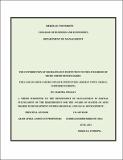| dc.contributor.author | Martha, Welday | |
| dc.date.accessioned | 2014-11-28T16:26:29Z | |
| dc.date.available | 2014-11-28T16:26:29Z | |
| dc.date.issued | 2014-06 | |
| dc.identifier.citation | Martha Welday (2014) The Contribution of Micro-Finance Institution to the Livelihood of Micro Credit Beneficiaries: The Case of Lideta Micro-Finance, Adigrat Town, Tigray, Northern Ethiopia, Thesis. Mekelle:MU. | en_GB |
| dc.identifier.uri | https://opendocs.ids.ac.uk/opendocs/handle/20.500.12413/5262 | |
| dc.description.abstract | Micro –finance plays a great role in improving the livelihood of its beneficiaries. The objective of this study was to assess the contribution of Lideta Micro-Finance Institution (LMFI) to the livelihood of the beneficiaries’ case of Adigrat. In order to see the MF contribution to the livelihood of beneficiary previous researches in Tigray focused mainly on physical and financial capital based conditions. This research has incorporated limited financial, human and social indicators in the assessment of the contribution to livelihoods. The information for the purpose of assessing the contribution of LMFI to the livelihood of beneficiaries was obtained from primary and secondary sources. 120 respondents with at least four years stay in the institution have been selected using purposive sampling. Quantitative and qualitative data were collected through semi-structured questionnaires and ten beneficiaries addressed through a questionnaire have also participated in focus group discussion. Further, the interview was conducted with five members of LMFI experts and Community Development Workers (CDW). The result of the study suggests that program participation has a positive contribution to the household income and social performance. However, the rate of children school enrolment before and after beneficiaries joined the institution showed no changes at all. Whereas, the beneficiaries care for their child's education in the form of providing school materials and making strict follow up on their education has shown positive changes after they joined the institution. Besides, the children of the beneficiaries have invested their time in helping the business in a way that does n’t interfere with their education. Hence, government bodies, nongovernmental and other concerned bodies by taking this result into consideration, they should work for further progress of MF. | en_GB |
| dc.language.iso | en | en_GB |
| dc.publisher | Mekelle University | en_GB |
| dc.rights.uri | http://creativecommons.org/licenses/by-nc-nd/3.0/ | en_GB |
| dc.subject | Finance | en_GB |
| dc.title | The Contribution of Micro-Finance Institution to the Livelihood of Micro Credit Beneficiaries: The Case of Lideta Micro-Finance, Adigrat Town, Tigray, Northern Ethiopia | en_GB |
| dc.type | Thesis | en_GB |
| dc.rights.holder | Mekelle University | en_GB |


